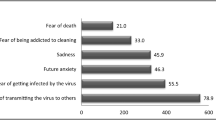Abstract
Objectives
Panic behavior poses a particular threat to the health and safety of subaquatic occupational specialists. Trait anxiety has previously been identified as a marker of panic behavior under water, and Spielberger’s State-Trait Personality Inventory (trait anxiety subscale) has been previously used to measure trait anxiety among subaquatic specialists. Using archived data, the trait anxiety scores of subaquatic specialists were analyzed to meet 3 objectives: 1stly — to develop a trait anxiety profile of subaquatic specialists; 2ndly — to investigate the predictive value of trait anxiety measures upon entering an occupational field; and 3rdly — to establish the reliability of these scores over time.
Material and Methods
Archival trait-anxiety data from 322 subjects were analyzed statistically.
Results
Analysis of the available scores revealed a highly homogenous as well as a very low trait anxiety profile for the investigated occupational group. Additionally, low trait anxiety was somewhat associated with success during specialist training: fewer candidates with high trait anxiety scores completed their qualification. Moreover, measurement of trait anxiety was stable over time, which suggests that when scores for this occupational group are screened, deviations from previous scores could signify a potential need for referral to an intervention from health professionals.
Conclusions
Using the trait anxiety subscale as part of occupational health surveillance of subaquatic specialists could support prevention of accidents by identifying high-risk candidates during their annual health assessments, and referral for timeous intervention.
Similar content being viewed by others
References
Morgan WP. Anxiety and panic in recreational scuba divers. Sports Med. 1995;20(6):398–421, http://dx.doi.org/10.2165/00007256-199520060-00005.
Bachrach AJ, Egstrom GH. Stress and performance in diving. San Pedro, Ca.: Best Publishing Company; 1987.
Colvard DF, Colvard LY. A study of panic in recreational scuba divers. Undersea J. 2003;Q1:40–44.
Edmonds C, Thomas B, McKenzie B, Pennefather J. Diving medicine for scuba divers. 5th ed. Chapter 34. Sydney: Carl Edmonds; 2013.
Ladd G. When panic strikes. Hangline. 1997;2(1) [cited 2013 Dec 7]. Available from: http://www.psychodiver.com/html/panic1.html.
Griffiths TJ, Steel DH, Vaccaro P, Allen R, Karpman M. The effects of relaxation and cognitive rehearsal on the anxiety levels and performance of scuba students. Int J Sport Psychol. 1985;16:113–119.
Morgan WP, Raglin JS, O’Connor PJ. Trait anxiety predicts panic behaviour in beginning scuba divers. Int J Sports Med. 2004;25:314–322, http://dx.doi.org/10.1055/s-2004-815829.
Colvard DF. Identifying anxiety and panic risk in divers [unpublished]. Proceedings of the DAN-SA Diver Stress and Panic Prevention Workshop; 2007 Sept 27, Johannesburg, South Africa [cited 14 Sept 2014]. Available from: http://www.divepsych.com.
Raglin JS, Stegner AJ. Psychobiological aspects of panic in SCBA and SCUBA. Int J Sport Exerc Psychol. 2005;4:446–454, http://dx.doi.org/10.1080/1612197X.2005.10807317.
Biersner RJ, LaRocco JM. Personality characteristics of US Navy divers. J Occup Psychol. 1983;56:329–334, http://dx.doi.org/10.1111/j.2044-8325.1983.tb00139.x.
Van Wijk CH. The resilience of naval specialists: Their sense of coherence and its relationship with measures of personality. S Afr J Psychol. 2008;38(4):737–751, http://dx.doi.org/10.1177/008124630803800412.
van Wijk CH. Mental health measures in predicting outcomes for the selection and training of navy divers. Diving Hyperb Med. 2011;41(1):22–26.
Fourie M, van Wijk CH. Using mental health markers to predict diver training injuries [unpublished]. Proceedings of the SAMHS Annual Research & Academic Conference; 2013 Oct 30; Pretoria, South Africa.
Hobbs M, Kneller W. Anxiety and psychomotor performance in divers on the surface and underwater at 40 m. Aviat Space Environ Med. 2011;82(1):20–25, http://dx.doi.org/10.3357/ASEM.2869.2011.
Spielberger CD. Preliminary manual for the state-trait personality inventory. Tampa, Fl.: University of South Florida; 1996.
Institute for Maritime Medicine. Technical report: Preliminary norms for the STPI in the South African Navy. Simon’s Town: Institute for Maritime Medicine; 2008.
Bielec G, Blaszkowska J, Waade B. The anxiety phenomenon in scuba divers. Pol Hyperb Res. 2006;4(17):15–20.
Nyenhuis DL, Yamamoto C, Luchetta T, Terrien A, Parmentier A. Adult and geriatric normative data and validation of the profile of mood states. J Clin Psychol. 1999;55(1): 79–86, http://dx.doi.org/10.1002/(SICI)1097-4679(199901)55:1%3C79::AID-JCLP8%3E3.0.CO;2-7.
Paulhus DL. Measurement and control of response bias. In: Robinson JP, Shaver PR, Wrightsman LS, editors. Measures of personality and social psychological attitudes. San Diego, CA: Academic Press; 1991. p. 17–59, http://dx.doi.org/10.1016/B978-0-12-590241-0.50006-X.
van de Mortel TF. Faking it: Social desirability response bias in self-report research. Aust J Adv Nurs. 2008;25(4):40–48.
Coetzee N. Measurement of heart rate variability and salivary cortisol levels in beginner scuba divers. Afr J Phys Health Educ Recreation Dance. 2011;17(4):729–741.
Anegg U, Dietmaier G, Maier A, Tomaselli F, Gabor S, Kallus KW, et al. Stress-induced hormonal and mood responses in scuba divers: A field study. Life Sci. 2002;70(23): 2721–2734, http://dx.doi.org/10.1016/S0024-3205(02)01537-0.
Author information
Authors and Affiliations
Corresponding author
About this article
Cite this article
Van Wijk, C.H. The use of Spielberger’s State-Trait Personality Inventory (trait anxiety subscale) with naval subaquatic specialists. IJOMEH 27, 959–966 (2014). https://doi.org/10.2478/s13382-014-0321-5
Received:
Accepted:
Published:
Issue Date:
DOI: https://doi.org/10.2478/s13382-014-0321-5



